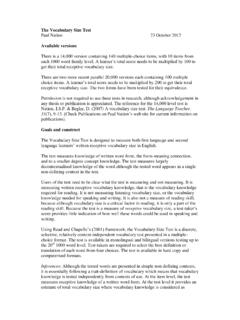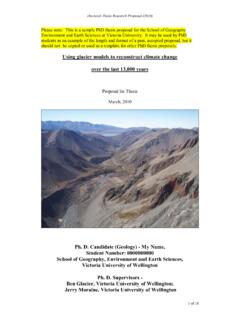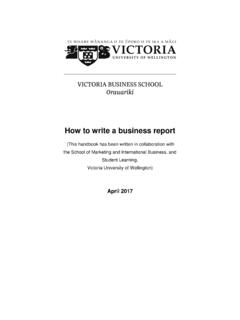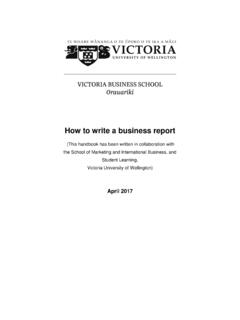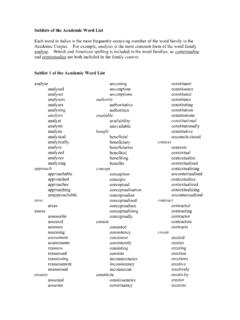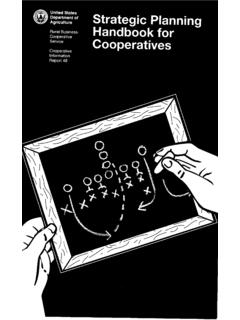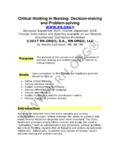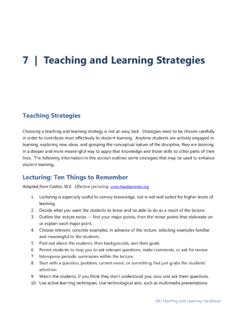Transcription of Group Work and Group Assessment - wgtn.ac.nz
1 CAD Guidelines I m p r o v i n g L e a r n i n g a n d T e a c h i n g Group Work and Group Assessment 2013 Edition Centre for Academic Development CAD Guidelines Group Work and Group Assessment Section Page Introduction 1 1. Working effectively with small groups 2 What is Group work? Why use groups ? How does Group work benefit the learner ? When to use Group work The course lecturer s role Key indicators of effective management of Group work Why assess Group work ? Potential problems with Group work Planning for Group work 7 Course objectives Task development Group formation Group size Group composition Managing the Group process 9 Group stages Creation of Group ground rules Group support 2.
2 Assessing Group work 11 Issues in assessing Group work Managing Group Assessment Plagiarism, Group work and legitimate co-operation Ensuring fairness Peer and self- Assessment 3. Evaluation and review reflecting on the quality of the Group work 17 Appendices 18 Bibliography 21 Contents CAD Guidelines 2 Group Work and Group Assessment Group work and Group Assessment guidelines Introduction For many years, groups have been used in higher education as a learning and teaching strategy. However, the widespread Assessment of Group work is a more recent phenomenon. Biggs and Tang (2007) cite two main reasons for this They aim to teach students interpersonal skills and graduate attributes relating to teamwork.
3 They reduce teachers marking loads. Both Group work and collaborative learning together, with or without associated Assessment , has been the subject of considerable research and discussion in the higher education literature ( , Boud & Falchikov, 2007; Davis, 1993; Falchokov, 2005). There are a wide variety of teaching contexts where Group work has been shown to enhance student learning. These guidelines are research based and are designed to assist teaching staff to use Group work in an educationally appropriate way that also meets the requirements of the Victoria University of Wellington Assessment Handbook (section ). The guidelines are divided into three sections.
4 The first identifies strategies that can be used to ensure that Group work is relevant, well planned and managed. The second section deals with the Assessment of Group work, whilst the final section of the guidelines provides some suggestions for evaluating the effectiveness of Group work. 1. Working effectively with small groups What is Group work? Group work, working in small groups or collaborative working as it is often referred is basically a Group of between two and six students formed to discuss a particular issue or perform a particular task. For clarification, it includes the terms: cooperative learning, collective learning, peer learning, reciprocal learning, or team learning.
5 Whichever construction is used, the reference is to learning that involves students in working with others and, crucially, learning together on a foundation of student-student interaction (Biggs & Tang, 2007), together with the concept of learning from each other (Race, 2007). Group work can, therefore be used to achieve a range of teaching and learning goals. Return to index CAD Guidelines 3 Group Work and Group Assessment While the terminology varies, the literature identifies three types of Group work (Davis, 1993): Informal groups that are composed of ad hoc clusters of students who work in class to discuss an issue or test understanding. Formal groups are established to complete a specific task in a single or several class sessions over many weeks, ( , project work, library or research tasks, progress reports, laboratory experiments, presentations, debates, field studies, musical performances).
6 The work of a formal Group may or may not be assessed. Study groups or teams that are specifically formed to provide support for members; usually for the duration of a course. These guidelines deal mainly with the second type of Group ( , the establishment, process and Assessment of formal learning groups). Why use groups ? Group learning is about people working together in carefully designed learning environments. A clear rationale for assigning Group work is to be found in Race (2007) who offers a practical and academic framework of the processes and issues arising. He argues that the human species has evolved on the basis of Group learning. Learning from others is the most instinctive and natural of all the learning contexts that we experience (Race, 2007).
7 Research shows that well-constructed Group work with a clear rationale and conviction of the value of the process leads to a greater retention and understanding of what is taught (Boud, Cohen & Sampson, 1999; Millis & Cottell, 1998). To ensure that Group work is both well designed and conducted, a number of universities have developed some sound and detailed guidelines in this area ( , University of Technology Sydney, University of Western Australia, University of Texas (US), Oxford Brookes (UK) and our own Victoria Business School). Graduate employability is increasingly emphasised by the Government and the TEC, with New Zealand employers seeking multi-skilled graduates with strong interpersonal, communication and social skills.
8 Other highly valued attributes include problem solving, evaluation, and teamwork. These Return to index CAD Guidelines 4 Group Work and Group Assessment qualities are recognised in graduate programme attributes and course objectives. Carefully planned Group work provides an opportunity for students to develop and nurture these important skills and attributes. How does Group work benefit the learner ? Group work can benefit the learner in the following ways: It encourages questioning, discussion and debate and can advance motivation to learn by raising interest levels. Students get to know each other and develop working relationships, which can have wider and lasting benefits.
9 It engages students as active participants and gives them opportunities of learning by doing. They are put in situations where they have to communicate and explain what they are doing, why they are doing it and take account of the views of others. It safeguards against students being isolated, particularly in their first year, and hence serves as a valuable retention strategy. Students have an opportunity to work with others whose learning experiences may be different to their own. In forming a Group ethos there is an emphasis on how you learn as well as what you learn. It develops students transferable skills of collaboration, team-working, negotiation, listening, organisation, leadership and evaluation, which students can take into their working lives.
10 It enhances student satisfaction of their learning experience and can nurture and promote self-esteem. It can stimulate creative ideas through brainstorming, engaging in discussion and through debate of different perspectives on the approach to a particular task. Group work provides a platform to nurture independent and lifelong learning. Students can gain confidence, become more aware of their strengths and are encouraged to develop their own ideas. Group work can allow students to undertake a wider variety of assignments. Work done in groups can often simulate the tasks students might do in real world situations. Return to index CAD Guidelines 5 Group Work and Group Assessment When to use Group work?
